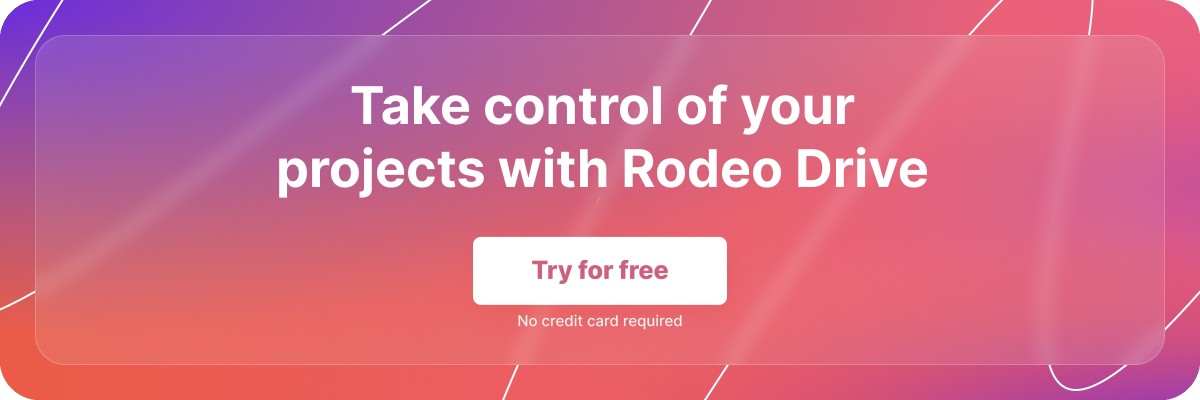An Introductory Guide to Agile Project Management
Imagine you’ve built the perfect project plan. The scope is clearly defined, resources are allocated, and every deliverable is laid out on a timeline for the next six months.
As the project gets running, everything is going according to plan. You did your part, after all. Then, halfway through the project cycle, the customer realizes the solution they asked for isn’t what they needed. Significant changes must be made to existing work and now, your perfect plan no longer applies.
The agile project management approach is designed to overcome this exact situation. It’s an iterative process that constantly engages customer feedback, allowing project results to adapt to customer needs as they change.
What is agile project management?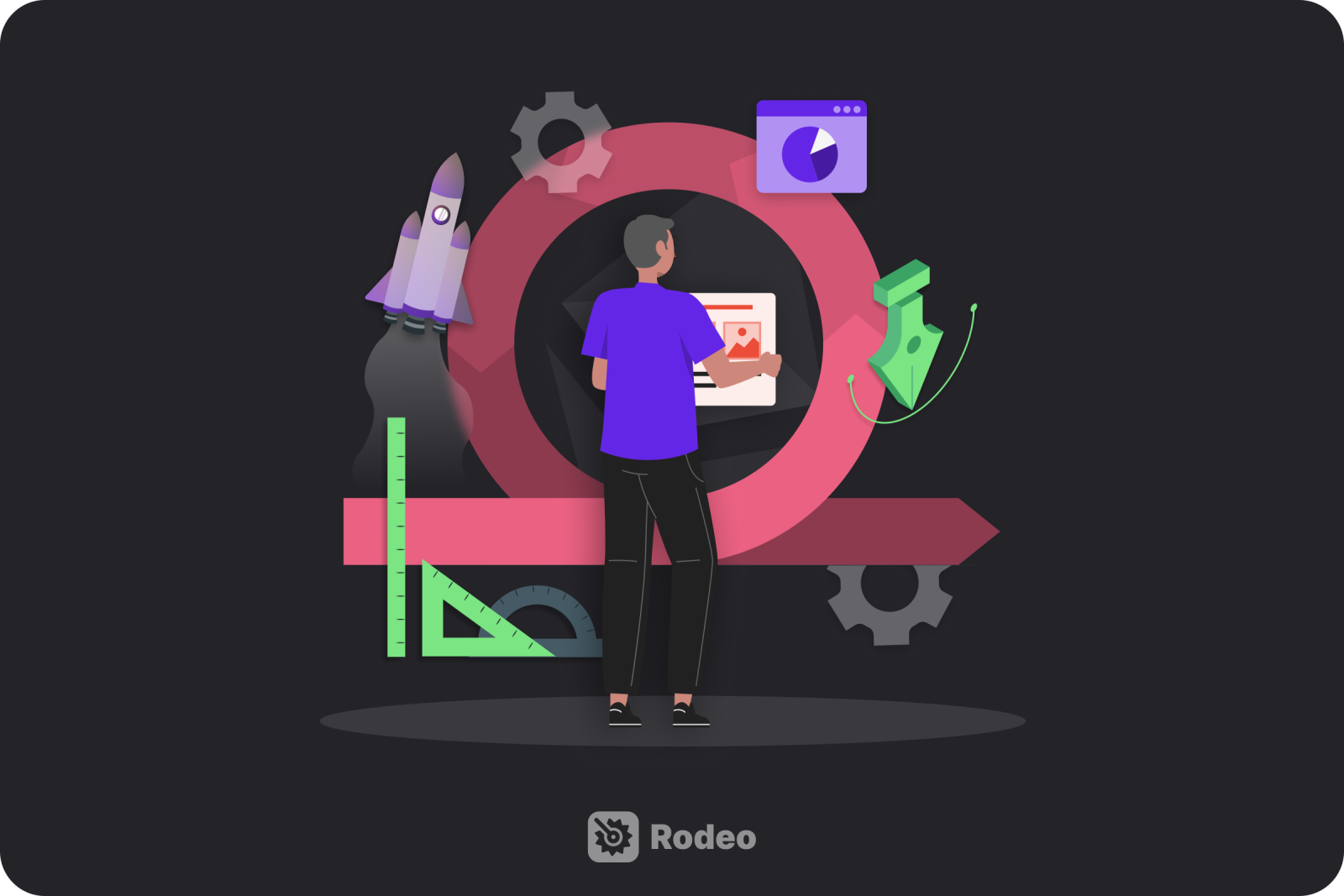
Originating in software development projects, agile project management is an iterative, feedback-driven approach to projects that emphasizes speed and adaptability. Agile teams work in sprints, which are two to four-week windows where they complete and deliver a feature or phase of a project.
The agile project approach evolved during the “application development crisis” of the 1990s. This was a time when demand for new software increased dramatically, but project management techniques still followed a linear, assembly-line style approach based on factory work.
Before the agile methodology, new software technologies took an average of three years to make. Concerningly, when companies were finally ready to bring their software products to market, they would discover that their customers’ needs had changed, or competitive solutions had already been adopted in the meantime. All of this resulted in many costly, failed projects.
Why is agile methodology useful?
Agile methodologies are useful because they break large, complicated projects into smaller more manageable chunks.
This modular approach allows teams to assess and revise each segment as they go, ensuring that each part aligns with project expectations.
Additionally, the iterative nature of Agile gives regular opportunities for stakeholder feedback, reducing the risk that the project underperforms once it is delivered.
5 benefits of agile project management
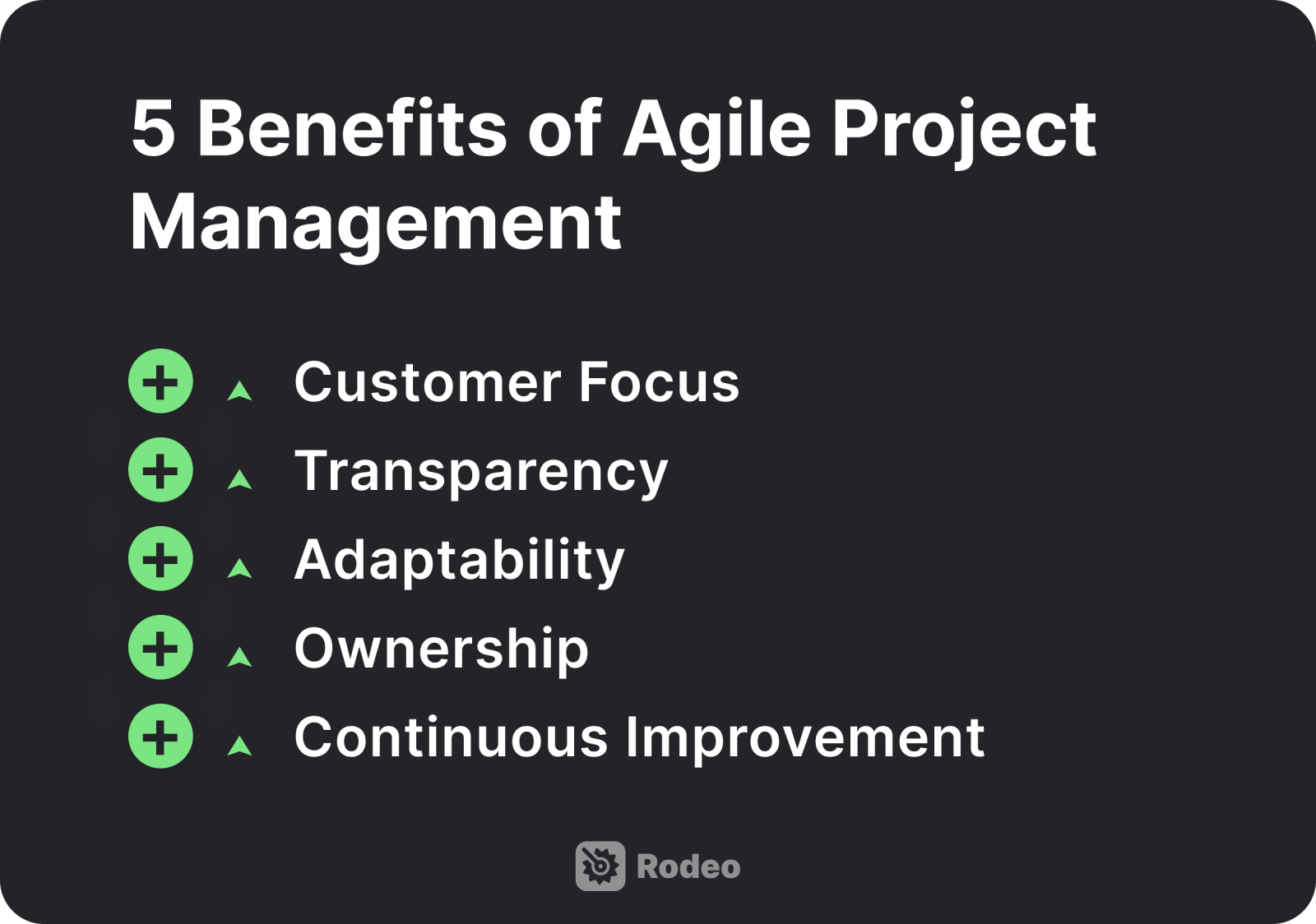
All agile methodologies aim to bring five elements into the project lifecycle: customer focus, transparency, adaptability, ownership, and continuous improvement.
Customer focus
Agile methodologies prioritize customer needs. They recognize that these can change throughout a project timeline. It follows that customers should be involved in each project phase for feedback, ensuring the outcome aligns with their preferences.
Transparency
Agile stresses that work is visible and openly communicated. It encourages team members to maintain transparency on individual tasks and deliver honest input on aspects of the project they believe won’t work as planned.
Adaptability
The iterative nature of agile projects allows them to rapidly respond to changes. Work is divided into small, time-limited segments, allowing teams to quickly shift their attention to new priorities.
Ownership
Agile decentralizes decision-making, encouraging all team members to take ownership of the project. This approach encourages decisions to be debated and evaluated for their merit before going forward. Inviting team members’ input also boosts team morale and engagement.
Continuous Improvement
A central part of agile is ongoing development and learning. Teams are encouraged to reflect on their processes and refine their skills, encouraging both better project management and professional growth
Agile vs. traditional project management
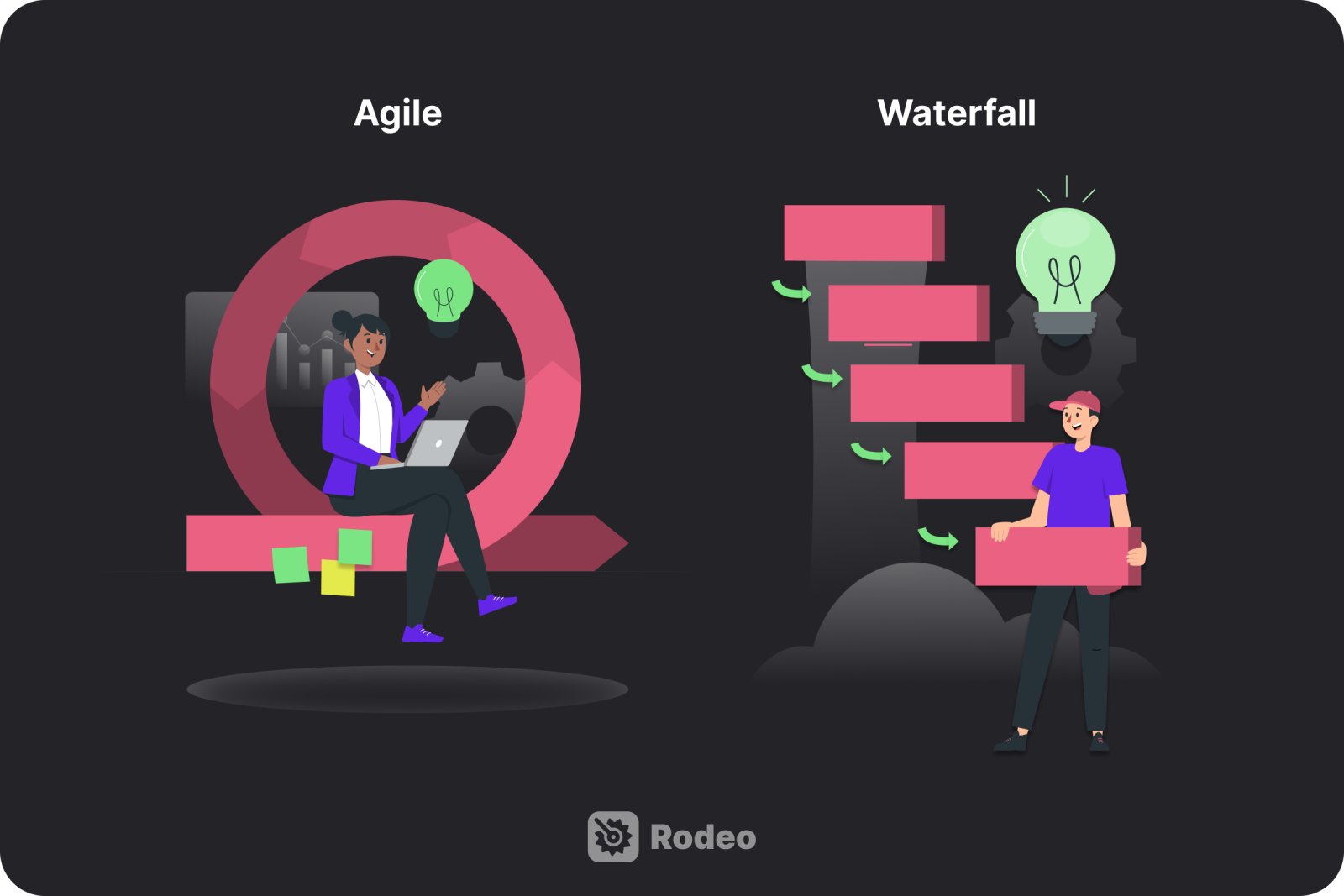
Traditional project management, which includes frameworks like the waterfall method, is a more step-by-step approach. Work activities are divided into phases, and then completed chronologically until the project is completed.
Waterfall project plans are decided in advance by a project manager. They might be relatively broad and extend over months and even years, with team members closely following the plans until the project reaches closure.
This approach works best for projects that have one clear deliverable and only require linear steps to reach that deliverable. For example, a construction project that finishes with a completed building, or a video production project that finishes with a commercial.
Agile project management works better for projects that have many components and dynamic requirements.
Software products are a clear example. During the process, client preferences can change, requiring sudden adaptation. Or, for newer companies looking to achieve product-market fit, old features may need to be scrapped and new ones added to respond to feedback from the market.
What agile projects share in common is that they have a loosely desired outcome, but they also require periodic re-evaluation and adjustment of project milestones to reach that outcome.
The 12 foundational principles of agile project management
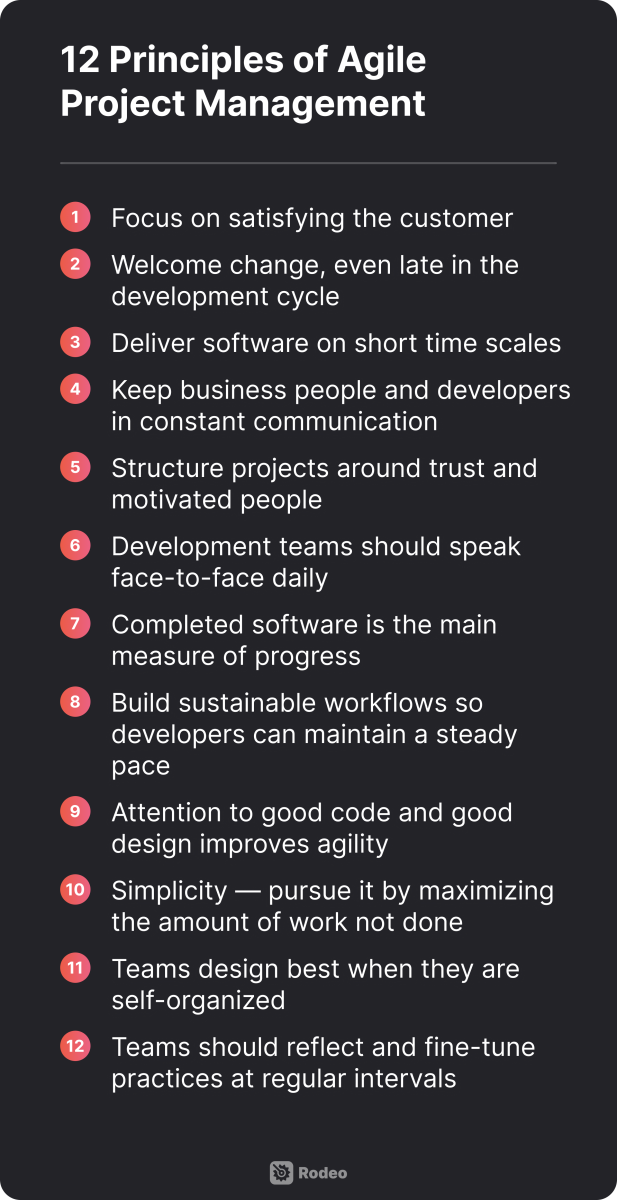
In February 2001, a group of 17 software professionals formalized the foundations of current agile thinking in a document called “The Manifesto for Agile Software Development.”
These professionals agreed on four values that should guide software projects. These values include:
- Prioritizing interactions between people instead of dependence on processes.
- Creating functional results instead of constant documentation.
- Fostering collaboration with customers instead of assuming you know what's best.
- Responding to change over strict adherence to long-term plans.
Following up on these four values, they created 12 rules for project management to help teams become agile. They are:
- Focus on satisfying the customer
- Welcome change, even late in the development cycle
- Deliver software on short time scales
- Keep business people and developers in constant communication
- Structure projects around trust and motivated people
- Development teams should speak face-to-face daily
- Completed software is the main measure of progress
- Build sustainable workflows so developers can maintain a steady pace
- Attention to good code and good design improves agility
- Simplicity — pursue it by maximizing the amount of work not done
- Teams design best when they are self-organized
- Teams should reflect and fine-tune practices at regular intervals
Using these principles, teams become more adaptable and more aligned with customer needs. The results are faster deliveries of work and relevant project outcomes for clients.
7 agile frameworks that you can implement
While agile is the overarching methodology, its principles can be applied through many different frameworks. The right framework largely depends on the nature of your projects and the structure of your teams. Here are seven popular agile frameworks to explore.
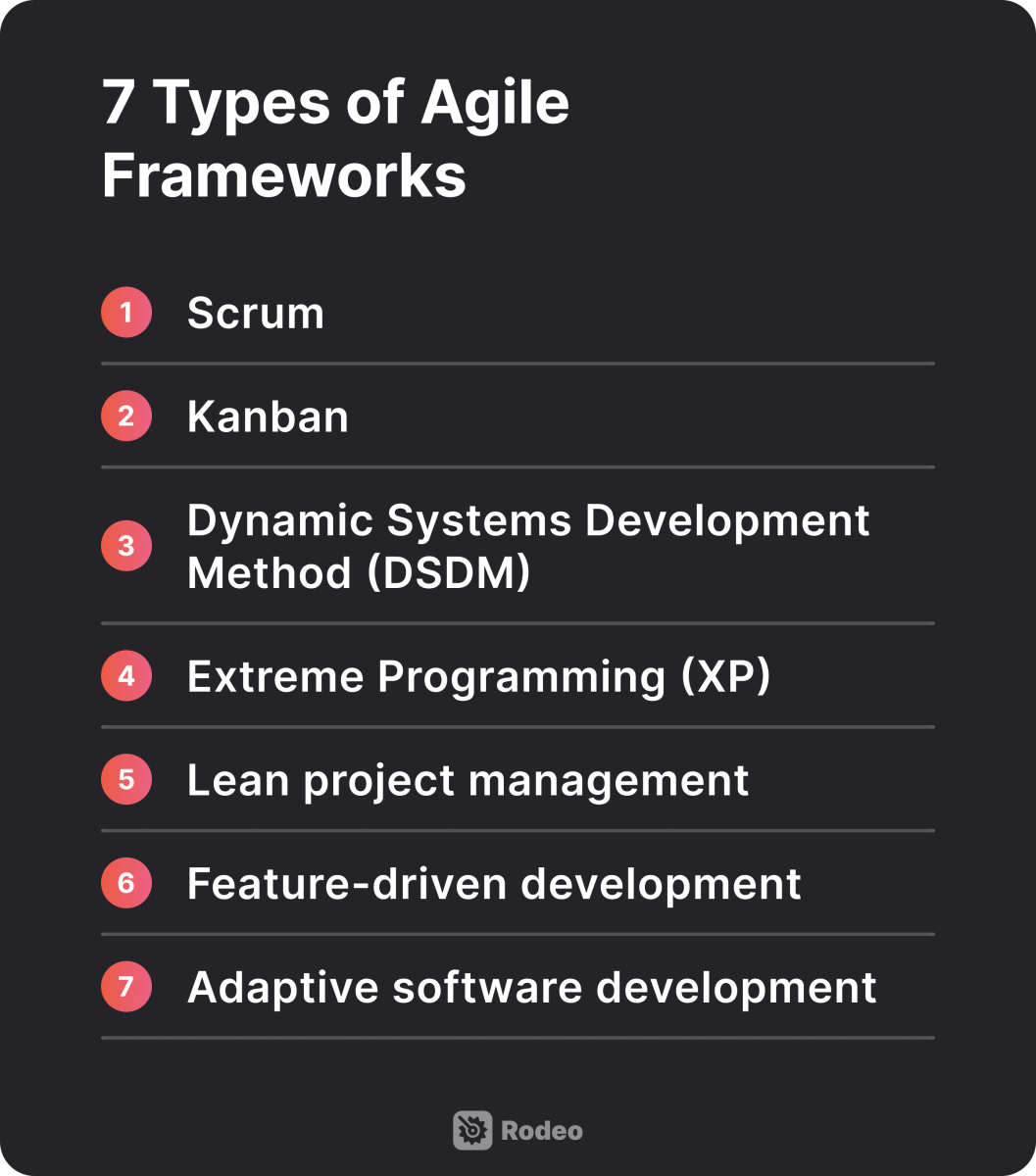
1. Scrum
Scrum is the most widely used agile framework, adopted by 66% of agile teams, and is especially popular in software development. It’s a well-defined, structured approach with many supporting resources available to learn it.
Scrum divides projects into short manageable periods called sprints, lasting two to four weeks. Before a sprint, a team will list a set of tasks it wishes to complete. Then during the sprint, the team will work through those predefined tasks, aiming to finish all of them by the end of the sprint.
Scrum requires some people in your organization to adopt special project roles. There is first the Scrum master, who facilitates communication and intervenes when the project runs into an obstacle. There is then a product owner, who represents stakeholders’ interests and communicates them with the development team.
The development team itself is responsible for self-organizing their work to get everything done in time. Regular meetings — such as the Scrum team’s daily standups — aim to foster constant communication and iteration.
2. Kanban

Kanban originated from lean manufacturing practices in Japan, specifically in the auto industry at Toyota. It is a visual work management technique that helps teams understand their work, limit work-in-progress, and maximize productivity.
Kanban is less structured than Scrum. It uses boards and cards to represent work items and their status, but it doesn’t specify how those items should be completed. Instead, teams use Kanban boards to identify bottlenecks in real time.
Kanban is suitable for teams that need to manage priorities and that already have principles in place for completing individual work items.
3. Dynamic Systems Development Method (DSDM)
The Dynamic Systems Development Method (DSDM) is a feedback-based system that covers an entire project lifecycle. DSDM is known for its strong emphasis on business needs. Its general principles are similar to the basic agile methodology, just with best practices more centered around active user involvement, frequent delivery, and team autonomy.
The method can be broken down into four phases. The first phase called the pre-project, involves feasibility studies and perhaps a proof of concept. The next phase, exploration, outlines the scope of the project and lays out technical details.
Next is the engineering phase, where the project is completed in strict sprints that demand on-time delivery. Finally, the project is incrementally deployed, and depending on user feedback, it may loop back to the pre-project stage, iterating until it meets internal and user requirements.
4. Extreme Programming (XP)
Extreme programming (XP) is an agile framework focused on enhancing software quality and responding to changing customer requirements. XP emphasizes teamwork, technical excellence, and customer satisfaction.
Key practices include pair programming, test-driven development, continuous integration, and frequent releases.
XP is effective in environments where requirements are unclear or need constant adaptation. It works well when there’s direct communication between developers and customers, or in contexts like open-source software, where there is a public element to the development process.
5. Lean project management
Lean project management focuses on delivering value with as little waste as possible. The approach is oriented toward detail and efficiency.
The key principles of the framework include:
- Identifying value.
- Value-stream mapping, which means creating a visual diagram of every critical step in a process.
- The pull principle, in which teams aim to only make what the customer asks for.
- Pursuing perfection.
Lean project management is ideal for organizations seeking to improve processes and optimize project scope.
6. Feature-driven development
Feature-driven development is a short-iteration, small-increment software development process. It is structured around completing useful, working software quickly and repeatedly.
In practice, the process begins by defining the scope and context of the system being developed. Then, during the planning phase, the project team will build a feature list — a narrow set of client-valued functions.
For each feature, a design session is held, usually involving domain experts and a product owner to ensure accuracy and relevance. After planning is finished, the features are developed in short iterations lasting one to two weeks, with time allocated between sprints for feedback and adjustments.
7. Adaptive software development
Adaptive software development focuses on the rapid creation and improvement of software. It’s suited for long, complex projects with evolving requirements. Adaptive development has three key practices that can be adapted to projects beyond software. These include:
Speculation: This involves envisioning project outcomes and brainstorming which outcomes are concrete and which are allowed to change as the project progresses.
Collaboration: Adaptive development encourages direct collaboration between team members and stakeholders. Rather than limiting this function to a product owner or project manager, team members are encouraged to communicate with stakeholders so that all perspectives are considered during the development process.
Learn: Continuous learning is the final element. The team has regular sessions to reflect on recent successes and failures for the sake of improving processes

Common challenges teams experience when introducing agile project management
Transitioning to an agile project management method can be transformative. However, it’s not something that happens overnight. The shift comes with its own set of challenges.
These challenges range from adjusting to new workflows to managing team dynamics – since agile approaches extensively require their initiative. Knowing these hurdles can ease the transition, helping your team successfully implement agile methodologies. Here are some common challenges teams will encounter when transitioning to agile:
1. Lack of understanding and training
Agile principles aren’t intuitive, yet they must be understood equally by everyone for success. Teams new to agile might struggle due to insufficient training or a misunderstanding of agile practices.
2. Difficulties in continuous collaboration
Ongoing collaboration requires consistent communication. If your organization is new to agile, it will need to create a structure for meetings to foster that collaboration. Teams might find it challenging to adapt to this increased level of interaction, especially in remote or higher individualized settings.
3. Resistance to change
Team members might be comfortable with traditional project management methodologies. This might make them resistant to learning a newer approach that requires more overhead.
4. Managing changing priorities
Agile’s dynamic nature means priorities can shift frequently. If teams don’t have project management infrastructure already in place, it can become hard to keep up, resulting in confusion and delays.
To overcome these challenges, teams should focus on:
- Encouraging open communication
- Providing training and learning opportunities
- Setting clear expectations
- Building a collaborative culture
By being proactive in addressing these challenges, teams can effectively integrate agile project management, ultimately leading to improved workflows and project outcomes.
Manage your projects with Rodeo Drive
Project management is never one-size-fits-all. Frameworks need to be adapted to the unique problems each project aims to solve.
While we explained some of the most popular agile methodologies, the right solution for your company will depend on the nature of your projects and teams. You might even benefit more from traditional project management than from agile methodologies. It’s simply dependent on the particular circumstances of your company.
If your team has just started improving its project management, Rodeo Drive is a smart, easy-to-use solution. Some companies have made their projects 30% more profitable after adopting it.
Let’s take a look at the features Rodeo Drive has to offer:
Enhanced financial management
Agile requires flexibility, but changing the direction of a project can have financial implications. Staying on top of your budget is essential, and Rodeo Drive has the tools to help.
Rodeo Drive is a straightforward solution for managing project budgets. The platform simplifies budget allocation, even for those without financial expertise. You can plan project costs by activities and by phases, and receive real-time insights since your budget will automatically update to reflect your team’s spending as they work.

Build your project budgets in Rodeo Drive and watch them update in real-time as your team works
Project planning and resource management
Planning in Rodeo Drive keeps project teams flexible. In the planner, teams can schedule project activities and manage resources. Projects can be visualized by phase on timelines, ensuring that milestones are always transparent.
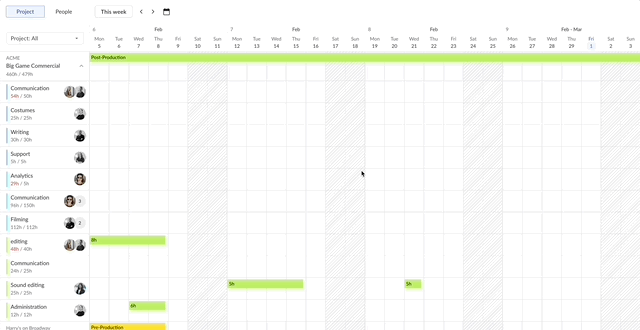
Timelines can be adjusted with the drag-and-drop feature, allowing plans to change as the project evolves
Real-time reporting
And finally, real-time reporting provides the latest insights into project progress and team productivity. Rodeo Drive offers three reports: projects, productivity, and time registration — all of which will provide insights into what your team has achieved and how they’re spending their time.
.png)
Time reporting in Rodeo Drive
These reports update in real time, which helps project leaders identify roadblocks and make timely decisions. In the long run, this also helps teams identify areas for improvement, fulfilling Agile’s tenant of continuous improvement.
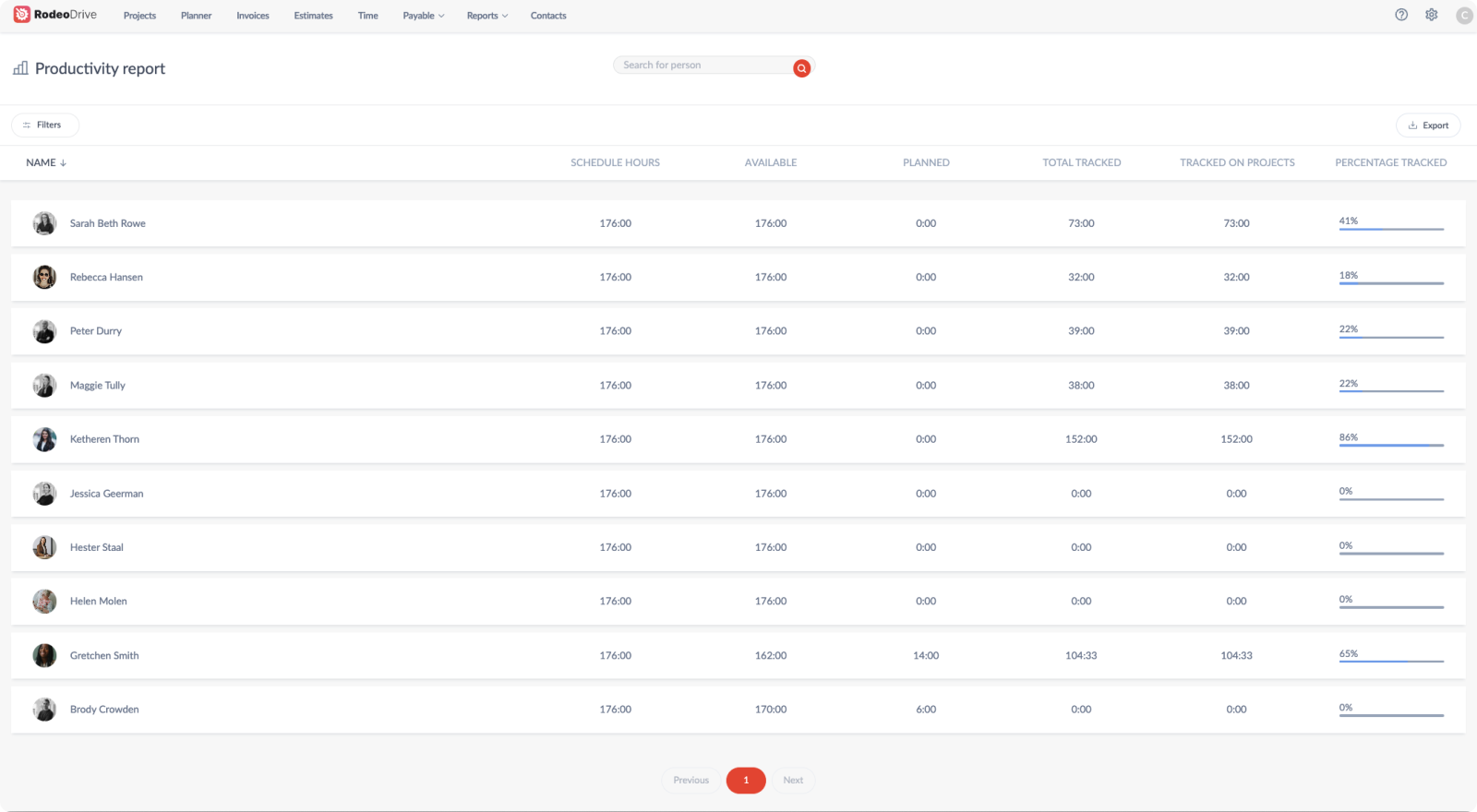
Productivity reporting in Rodeo Drive
For all that value you would think it’s expensive, right? Well, it’s not — you’ll have unlimited access to all of Rodeo Drive’s features for $14.99 per user/month, and the platform also offers a free plan. You don’t even need to enter a credit card number to sign up.





